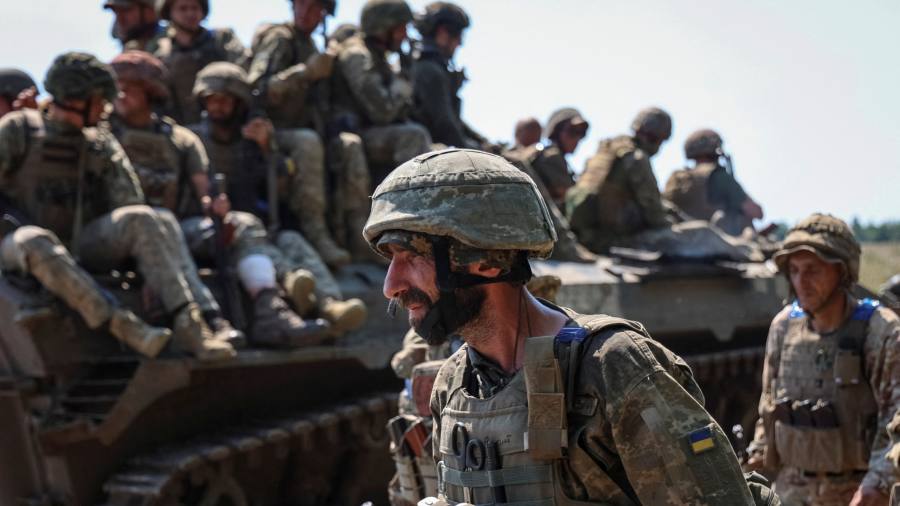Receive free War in Ukraine updates
We’ll send you a myFT Daily Digest email rounding up the latest War in Ukraine news every morning.
The writer is senior research fellow for land warfare at the Royal United Services Institute think-tank and has worked extensively in Ukraine during Russia’s full-scale invasion
For two months, Ukrainian forces have been on the offensive, trying to break through Russian defence lines to begin the liberation of the occupied territories. The fighting has been difficult and progress has been incremental. But over time, the Ukrainians have been securing the advantage. The question now is whether they can push Russian forces to breaking point.
After wasting thousands of troops in a failed spring offensive, the Russian military fell back to around 45km of defensive positions, stretching across the southern front from Zaporizhzhia through Donetsk, to prevent Ukrainian troops advancing towards the strategic, Russian-held city of Melitopol. The so-called Surovikin Line, named after a Russian general, comprises three lines of hardened trenches, each screened by dense minefields, anti-tank ditches, tank traps and wire entanglements. In front of these, Russian fighting positions are bolstered by anti-tank and anti-personnel mines.
Since the start of the offensive in early June, Moscow has adopted new tactics. Russian forces allow Ukrainians to enter the minefields and then aggressively counterattack, often with tanks and anti-tank guided weapons on the flanks. Once Ukrainian vehicles are knocked out, the Russians deploy mortars and artillery against the infantry. If Kyiv’s forces get across the minefields and into the trenches, the Russians often abandon their fighting positions and detonate prepositioned charges to kill the first wave of attackers.
After attempts to breach the minefields using explosives led to heavy Ukrainian casualties, Kyiv has adapted its tactics, infiltrating Russian positions to confuse the defenders and strike from the flanks, before attempting breaches. These methods have reduced Ukrainian losses, but the necessary planning and reconnaissance makes this a slow process, in which the Ukrainians fight for 700m at a time. This gives their opponents the chance to reset. But accelerating the process leads to an unacceptable rate of equipment loss. For the Ukrainians, the key is to manage their equipment, such as vehicles, to exploit a breach once it has been made.
As well as assaulting Russian positions, since early June Kyiv has also used precision missiles provided by its partners to destroy counter-battery radar. Without them, Moscow has found itself outranged and unable to locate Ukrainian artillery. Kyiv’s forces, by contrast, have become adept at locating Russian guns and destroying them with precision shells.
This systematic erosion of Russian artillery has been a turning point: for the first time in the war, Ukrainian howitzers can deliver sustained fire on to Russian positions. It also means that Moscow — while still destroying Ukrainian vehicles in the minefields — has less artillery power to kill the infantry that emerge from them. As a result, Ukrainian troops are succeeding in taking Russian positions, even when their vehicles are caught in the open.
In response, Moscow has had to be more aggressive with its own armoured vehicles. This has inflicted heavy casualties on Ukrainians, but deploying such vehicles close to the front has left them vulnerable. During the day, dozens of Ukrainian drones surveil the battlespace, filming and identifying targets. At night, these units send repurposed agricultural drones carrying rocket-propelled grenades to hunt for Russian armour.
The attrition of critical equipment is important for Kyiv both tactically and operationally. Ukraine has been using Storm Shadow cruise missiles supplied by the UK to hit command posts, ammunition depots and bridges behind Russian lines. Together, the destruction of artillery, armour, radars and the loss of supplies are leaving Moscow’s infantry with diminishing support. However, Russian units continue to fight hard and Ukraine’s own equipment losses remain high. Kyiv’s forces are struggling with persistent Russian attack helicopters, which sit 8km to 10km from the front at low altitude, safe from air defences, and fire anti-tank missiles at Ukrainian vehicles.
The question is which side can sustain the current rate of attrition. On the southern front, Russia’s 58th Combined Arms Army has borne the brunt of the fighting. About a quarter of the force is in the fighting positions at any one time and the Russians have had to rotate troops. They have few reserves. Ukraine, meanwhile, has fed additional units from the 10th Corps into the fight, keeping up the pressure. At some point, Russia’s infantry might be spread too thin and, with insufficient artillery and armoured support the defence could crumble. Dry weather will allow Ukraine to continue its push until the beginning of November. This will be a critical point: from then on, progress will depend on which side has made better preparations for winter fighting.
The stakes are high for Kyiv. If it breaks through it could liberate significant amounts of territory and force Russia to surge new units into Ukraine before they have finished training. Conversely, if Ukraine fails to breach the Surovikin Line then Russia can keep new units back, train and prepare them, and regain the initiative. Either way, Kyiv will need ongoing international assistance. But by autumn, the trajectory of the conflict will be clear.
Read the full article here



